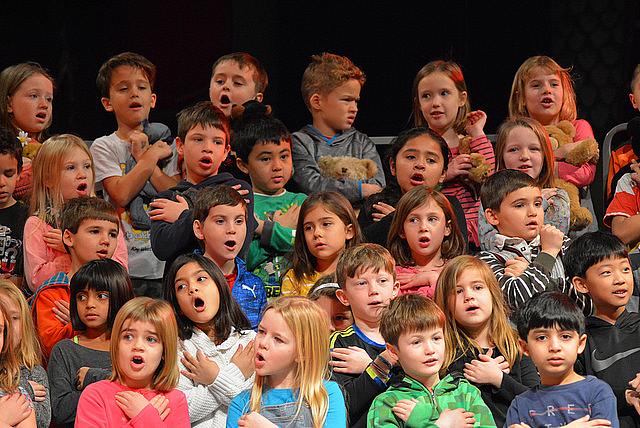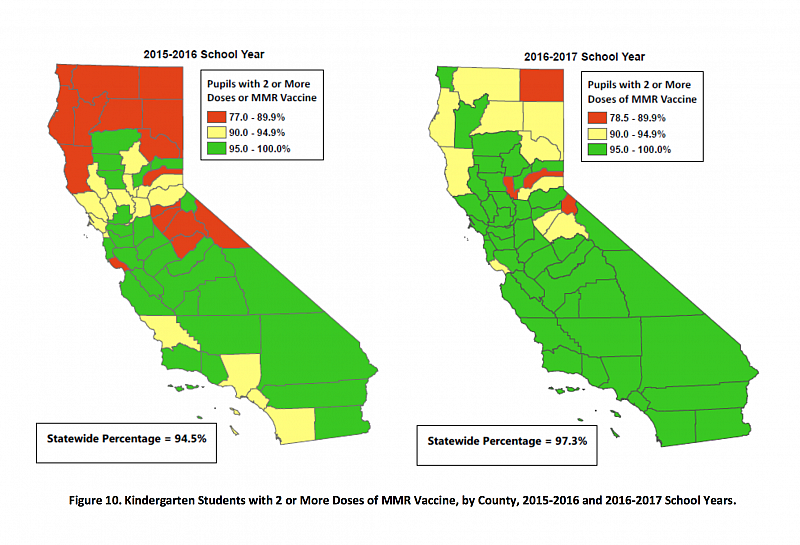California, Michigan see quick payoffs for tougher vaccine requirements

When California Governor Jerry Brown signed a tough new law that barred the state’s schoolchildren from receiving “personal belief” exemptions from required vaccines in 2015, I suggested it would be worth tracking how the policy shift played out in the real world.
Well, fast forward nearly two years, and we now have some early numbers on how immunization rates are changing, and by inference, how well the law might be working.
The share of California kindergarteners who received all required shots rose from 92.8 percent in the 2015-16 school year to 95.6 percent this year, according to the California Deptartment of Public Health. That marks a 5.2 percent increase in vaccinations from 2014-15 and is the highest rate the state has seen since current immunization requirements went into effect in 2001.
Far more kindergarteners are now vaccinated for measles — 97.3 percent — than in 2014, when 92.6 percent were vaccinated and headlines carried news of a multistate measles outbreak that was first traced back to Disneyland and ultimately to low vaccination rates.
This map released by the state shows what a difference a school year can make for immunization rates for the measles, mumps and rubella (MMR) vaccine:

That would seem like heartening news for policymakers eager to use legislative levers to bolster public health. “SB277 works,” tweeted state Sen. Richard Pan, a pediatrician who co-authored the legislation that clamped down on vaccine exemptions for school kids. “We halted the bleeding,” Pan told the Los Angeles Times.
These numbers are early, and several more years worth of data will help show whether the trend holds up. And, of course, it’s very difficult to neatly prove cause-and-effect when so many variables are at play. Did the Disneyland outbreak and subsequent media blizzard nudge more parents to get their kids vaccinated? Did the new legislation account for the gains? In addition, California stepped up audits of schools that have had higher rates of students behind on the immunization schedule, so that could’ve helped as well. Yet it’s safe to say all of these forces are pulling in the same direction.
Not everywhere equally, however. The rural northern third of the state still has a disproportionate share of counties with lower kindergarten vaccination rates. Sparsely populated counties such as Modoc (where only 78.5 percent of kindergarteners have all shots), Nevada (with 81 percent) and Sutter (with 85.3 percent) have the lowest rates in the state. Journalists who cover those counties might investigate whether those lower numbers are the product of ideological objections or less access to health care — or whether they're the kind of statistical blips that often accompany smaller sample sizes.
On the same day that news broke of California’s vaccine gains, Kaiser Health News reported on Michigan’s markedly similar success story. In 2014, the state had the fourth-highest rate of kindergarteners with vaccine exemptions in the country. A new rule that required parents to meet with a health educator before receiving an exemption went into effect in 2015. The number of exemptions dropped 35 percent in the first year alone. “Research has shown that if you make it more inconvenient to apply for a waiver, fewer people get them,” Michigan State University social policy professor Mark Largent told KHN.
While Michigan’s so-called “stealth” approach to personal belief exemptions was markedly different from California’s contentious fight, the outcomes look pretty similar. More kids are getting their shots in these states, and that’s an encouraging counterpoint to the vaccine news coming out of Washington D.C. these days.
[Photo by VDE via Flickr.]

